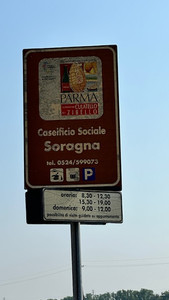Making Parmigiano Reggiano - Fare il Parmigiano Reggiano
- Maria Scuor
- Sep 10, 2024
- 9 min read
Scorri a basso per l’italiano
THANK YOU Caseifico Soragna - GRAZIE Caseifico Soragna
I LOVE Parmigiano Reggiano and today we spent the morning touring Caseificio di Soragna Parmigiano Reggiano cheese factory. La “Granda” dairy was founded in 1930 and since then the Soragna Cooperative Dairy has been creating this delicious cheese. It uses only the milk produced by members of the Cooperative to produce only Parmigiano Reggiano, in compliance with Consortium regulations.
The origins of Parmigiano Reggiano date back to the Middle Ages when the Benedictine and Cistercian monks wanted a cheese that could last a long time. They were the first producers using salt from the Salsomaggiore salt mines and milk from cows that belonged to the monks. Their process created a dry paste cheese in large wheels that was great for preservation.
A notarial deed dated 1254 is the first evidence that Parmigiano Reggiano was being sold as Caseus Parmensis (cheese from Parma). Then in the 14th century we see the cheese being traded in Romagna, Piedmont and Tuscany regions, also reaching the ports of the Mediterranean Sea. By the 15th century, the feudal lords and abbeys increased production in the Parma and Reggio and the weight size of the wheel went up to 18kg.
By the 16th century, cowsheds called “vaccherie” were dairies that produced milk specifically for the cheese. In those years, production started in Modena as well and recipes were started to be created using Parmigiano Reggiano. Parma merchants called “formaggiai and lardaroli” started trading to Milan, Cremona and exporting all around Europe.
On August 7, 1612, Ranuccio I Farnese wanted to protect the Parma cheese from other similar cheese on the market, therefore he made a designation of origin and the deed defined the places from where the cheese “from Parma” should come. This starts the concept of DOP Denominazione di Origine Protetta (Protected Designation of Origin and often indicated as P.O.D.). Designation of Origin at a European level.
Today, Parmigiano Reggiano is made the same as it was in the Middle Ages. With no additives and all natural. During the wars, it was tough times for cheese production but once the wars were over Parmigiano cheese was sought after therefore in 1954, the first Consortium was formed after Italian law on DOP came into affect. Now known as the Parmigiano Reggiano Cheese Consortium.
In 1992, new regulations on DOP to protect Parmigiano Reggiano were approved therefore in 1996 was Parmigiano Reggiano was recognized as a European DOP. Giving it protection from the many counterfeited and imitated cheeses in the world.
We didn’t realize if we wanted to watch them make the daily cheese wheels, we would have to go very early in the morning. Something we can do next time because it would be very interesting to watch this amazing cheese come to life.
The great thing about this tour was that Gianni and I were the only two on the tour which made it even more special because we got to ask all the questions we wanted. Here are the steps required to make a wheel of Parmigiano Reggiano cheese:
Depending on time of year this dairy makes 10 to 40 wheels of parmigiano Reggiano per day
Milk is received twice a day. The afternoon milk is placed in containers and skimmed of fats until the morning
In the morning 500 liters of the afternoon milk and 500 liters of the morning milk is added to the copper vats
The mixer starts mixing the milk and then heat and steam brings milks temperature to 27°C
At this point 25 gr of rennet is added into the milk to coagulate the milk and form curds. The milk now rests for ten minutes
A spino (hawthorn) tool is used to break the curdle into clumps as small as rice grains
Temperature is gradually raised to 55°C and the clumps expel moisture and fall to the bottom of the vat
Everything rests for 50 minutes, then the cheese maker, holding a wooden paddle, lifts the mass out of the vat
The mass is placed in a linen cloth to drain the water and the cheese mass is formed
The cheese mass is cut into two halves and each half is placed into its own linen cloth for further draining of water
The linen cloth covered cheese is then fitted into a wheel shaping mould
The wheels are flipped twice and the linen cloth is changed to absorb the moisture
In the evening the cloth is removed and a casein marking band is fitted between the wheel and outer belt
The name Parmigiano Reggiano, the site ID number, month and year of production, the EC seal and the DOP brand gets imprinted on the wheel overnight
Wheels are then moved into stainless steel molds for two days which gives the cheese the curved shape
The final ingredient salt is added by immersing the mold into salt and water for 14 days so that the cheese can absorb the salt
Ageing begins by placing wheels on wooden shelves in temperature and humidity-controlled environment
The first-year wheels are flipped, checked and brushed every ten days ensure no moisture or mold impact the cheese. This ensures the finest quality cheese
Parmigiano Reggiano must be aged 12 months to be classified DOP Parmigiano Reggiano
Experts from the protection consortium come to the diary and do a “quality inspection” on all the wheels
Each wheel is tapped with a hammer and the trained ear of the quality inspector recognizes any defects the cheese may have
The conforming wheels are marked with a hot-brand iron, and at this point the cheese becomes Parmigiano Reggiano. If a wheel doesn’t meet the DOP criteria, all markings are removed from the wheel
There are three categories of Parmigiano Reggiano:
“First-grade” is when the cheese fully complies with the production specifications and has been branded DOP
“Medium-grade” is when the cheese shows minor or moderate defects in the structure of its paste and/or on the rind. These defects don’t alter the characteristics of the product therefore these wheels are branded DOP, however parallel groves are engraved all around the cheese rind so it can be recognized as such
“De-rinded” is the cheese that shows major defects. Therefore a few millimeters of the rind is removed and this cheese cannot be called Parmigiano Reggiano or DOP brand
At this dairy they produce 12-, 24- and 50-month-old cheese. When looking at the wheels, the darker the skin the longer it has aged
We ended our tour with a tasting and paring with some wine. As expected, the three aged cheeses had different levels of flavour and one was better then the last. Of course I had to buy one of each aged cheese.
Here is my TikTok video and photos on how Parmigiano Reggiano is made - Ecco il mio video e le foto su TikTok su come viene prodotto il Parmigiano Reggiano
Outside of factory - Fuori dalla fabbrica
Milk processing and transformation - Lavorazione e trasformazione del latte
Shaping the cheese - Modellare il formaggio
Ageing the cheese - Stagionatura del formaggio
Inspecting and branding - Ispezione e marchio
Products - Prodotti
Fare il Parmigiano Reggiano
Adoro il Parmigiano Reggiano e oggi abbiamo passato la mattinata a visitare il Caseificio di Soragna. Il caseificio La "Granda" nasce nel 1930 e da allora la Latteria Cooperativa Soragna crea questo prelibato formaggio. Utilizza solo il latte prodotto dai soci della Cooperativa per produrre solo Parmigiano Reggiano, nel rispetto del disciplinare del Consorzio.
Le origini del Parmigiano Reggiano risalgono al Medioevo quando i monaci benedettini e cistercensi volevano un formaggio che potesse durare a lungo. Furono i primi produttori ad utilizzare il sale delle saline di Salsomaggiore e il latte delle mucche appartenute ai monaci. Il loro processo ha creato un formaggio a pasta secca in grandi forme che era ottimo per la conservazione.
Un atto notarile del 1254 è la prima testimonianza che il Parmigiano Reggiano veniva venduto come Caseus Parmensis (formaggio di Parma). Nel XIV secolo il formaggio viene commercializzato in Romagna, Piemonte e Toscana, raggiungendo anche i porti del Mar Mediterraneo. Nel XV secolo, i feudatari e le abbazie aumentarono la produzione a Parma e Reggio e il peso della forma salì a 18 kg.
Nel XVI secolo, le stalle chiamate "vaccherie" erano caseifici che producevano latte appositamente per il formaggio. In quegli anni inizia la produzione anche a Modena e si iniziano a creare ricette con il Parmigiano Reggiano. I mercanti parmensi chiamati "formaggiai e lardaroli" iniziarono a commerciare a Milano, Cremona ed esportare in tutta Europa.
Il 7 agosto 1612 Ranuccio I Farnese volle proteggere il formaggio di Parma dagli altri formaggi simili presenti sul mercato, pertanto fece una denominazione di origine e l'atto definì i luoghi da cui doveva provenire il formaggio "di Parma". Da qui nasce il concetto di DOP Denominazione di Origine. Denominazione di Origine a livello europeo.
Oggi il Parmigiano Reggiano è fatto come nel Medioevo. Senza additivi e tutto naturale. Durante le guerre furono tempi duri per la produzione casearia, ma una volta finite le guerre il Parmigiano fu ricercato, così nel 1954 nacque il primo Consorzio dopo l'entrata in vigore della legge italiana sulla DOP. Oggi noto come Consorzio del Parmigiano Reggiano.
Nel 1992 sono stati approvati i nuovi disciplinari sulla DOP a tutela del Parmigiano Reggiano e nel 1996 il Parmigiano Reggiano è stato riconosciuto come DOP Europeo. Dandogli protezione dai tanti formaggi contraffatti e imitati nel mondo.
Non ci rendevamo conto che se volevamo vederli fare le forme di formaggio ogni giorno, saremmo dovuti andare molto presto la mattina. Qualcosa che possiamo fare la prossima volta perché sarebbe molto interessante vedere questo fantastico formaggio prendere vita.
La cosa grandiosa di questo tour è che io e Gianni eravamo gli unici due del tour, il che lo ha reso ancora più speciale perché abbiamo avuto modo di fare tutte le domande che volevamo. Ecco i passaggi necessari per realizzare una forma di Parmigiano Reggiano:
A seconda del periodo dell'anno questo caseificio produce dalle 10 alle 40 forme di parmigiano reggiano al giorno
Il latte viene ricevuto due volte al giorno. Il latte pomeridiano viene messo in contenitori e scremato dai grassi fino al mattino.
Al mattino si aggiungono 500 litri di latte pomeridiano e 500 litri di latte mattutino ai vasche di rame
L'impastatrice inizia a mescolare il latte e poi riscalda e cuoce a vapore portando la temperatura del latte a 27°C
A questo punto si aggiungono 25 gr di caglio nel latte per coagulare il latte e formare la cagliata. Il latte ora riposa per dieci minuti
Uno spino viene utilizzato per rompere la cagliata in ciuffi piccoli come chicchi di riso
La temperatura viene gradualmente aumentata fino a 55°C e i grumi espellono l'umidità e cadono sul fondo della vasca
Il tutto riposa per 50 minuti, poi il casaro, impugnando una paletta di legno, solleva la massa dalla vasca
La massa viene posta in un panno di lino per far defluire l'acqua e si forma la massa di formaggio
La massa di formaggio viene tagliata in due metà e ogni metà viene posta nel proprio panno di lino per un ulteriore drenaggio dell'acqua
Il formaggio ricoperto di tela di lino viene poi inserito in uno stampo per la formatura delle forma
Le forme vengono capovolte due volte e il panno di lino viene sostituito per assorbire l'umidità
La sera il panno viene rimosso e una fascetta di marcatura della caseina viene inserita tra la forma e la cinghia esterna
Il nome Parmigiano Reggiano, il numero identificativo del sito, il mese e l'anno di produzione, il marchio CE e il marchio DOP vengono impressi sulla forma durante la notte
Le forme vengono poi trasferite in stampi di acciaio inox per due giorni che conferiscono al formaggio la forma curva
L'ingrediente finale: il sale viene aggiunto immergendo lo stampo in acqua e sale per 14 giorni in modo che il formaggio possa assorbire il sale
La stagionatura inizia con il posizionamento delle forme su ripiani in legno in ambiente a temperatura e umidità controllate
Le forme del primo anno vengono capovolte, controllate e spazzolate ogni dieci giorni per garantire che l'umidità o la muffa non influiscano sul formaggio. Questo garantisce la migliore qualità del formaggio
Il Parmigiano Reggiano deve essere stagionato 12 mesi per essere classificato Parmigiano Reggiano DOP
Gli esperti del consorzio di tutela si recano all'agenda e fanno un "controllo di qualità" su tutte le forme
Ogni forma viene picchiettata con un martello e l'orecchio allenato dell'ispettore di qualità riconosce eventuali difetti che il formaggio può avere
Le forme conformi vengono marchiate con l’apposito bollo a fuoco, e a questo punto il formaggio diventa Parmigiano Reggiano. Se una forma non soddisfa i criteri DOP, tutte le marcature vengono rimosse dalla forma
Esistono tre categorie di Parmigiano Reggiano
"Prima scelta" è quando il formaggio rispetta pienamente il disciplinare di produzione ed è stato marchiato DOP
"Di media qualità" si ha quando il formaggio presenta difetti minori o moderati nella struttura della pasta e/o sulla crosta. Questi difetti non alterano le caratteristiche del prodotto, per questo queste forme sono marchiate DOP, tuttavia sono incise delle scanalature parallele tutt'intorno alla crosta del formaggio in modo che possa essere riconosciuta come tale
"Denzonato" è il formaggio che presenta grossi difetti. Pertanto si tolgono pochi millimetri di crosta e questo formaggio non può essere chiamato Parmigiano Reggiano o marchio DOP
In questo caseificio si producono formaggi di 12, 24 e 50 mesi. Quando si guardano le forme, più scura è la pelle, più a lungo è invecchiata
Abbiamo concluso il nostro tour con una degustazione e l'abbinamento con del vino. Come previsto, i tre formaggi stagionati avevano diversi livelli di sapore e uno era migliore dell'altro. Ovviamente ho dovuto comprare un formaggio di ogni stagionatura.























































































Commentaires